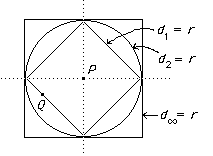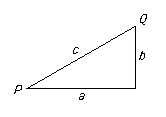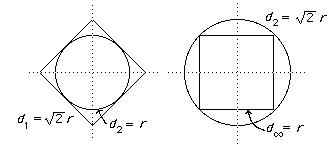
Look at the picture:
If a point Q is as shown, it is clear that d2(P, Q) ≤ r since "The diamond is inside the circle" and so d2(p, Q) ≤ d1(p, Q).
Similarly, "The circle is inside the square and so d∞(P, Q) ≤ d2(P, Q).

Alternatively, look at the picture:
Then d2(P, Q) = c ≥ a + b = d1(P, Q).
Also both a≤ c and b ≤ c ⇒ d∞(P, Q) = max{a, b} ≤ c.
Without a picture, one can argue
(a + b)2 = a2 + b2 + 2ab ≥ a2 + b2 ⇒ a + b ≥ √(a2 + b2) ⇒ d1≥ d2.
Also, if a ≥ b then max{a, b} = a and since a2+ b2≥ a2we have √(a2 + b2) ≥ a and so d2 ≥ d∞.

If (an)→ α in d1, then given ε > 0 ∃ N such that n > N ⇒ d1(an, α) < ε ⇒ (since d1≥ d2and d∞) that the sequence converges in d2 and d∞ also.

One can draw the pictures :
to show that d1≤ √2 d2 and d2≤ √2 d∞.
Alternatively, √2 √(a2 + b2) ≥ a + b ⇔ 2(a2 + b2) ≥ a2 + 2ab + b2 ⇔ a2 + 2ab + b2 ≥ 0 which is true since (a - b)2 ≥ 0. Hence √2 d2 ≥ d1.

If (an)→ α in d∞, then given ε > 0 ∃ N such that n > N ⇒ d∞(an, α) < ε ⇒ d2(an, α) < ε/√2 and d2(an, α) < ε/2 and so the sequence converges in d1 and d2 also.
Similarly, if convergence takes place in d2 it also takes place in d1. Combining this with the earlier result shows that sequences which converge in one of these metrics converge in them all.
 nxn- nxn+1dx = [n/(n + 1) xn+1 - n/(n + 2) xn+2
nxn- nxn+1dx = [n/(n + 1) xn+1 - n/(n + 2) xn+2  = n/[(n + 1)(n + 2)]→ 0 as n→ ∞.
= n/[(n + 1)(n + 2)]→ 0 as n→ ∞.Thus (fn)→ the 0-function.
To find the maximum, solve d/dxfn(x)= 0 to get:
n2xn-1 - n(n+1)xn = 0 ⇒ x = n/(n + 1) or 0.
The maximum is at n/(n + 1) and is thus [n/(n + 1)]n = [1 - 1/(n + !)]n+1→ e-1as n→ ∞ (by Exercises 6 Question 7).
Thus d∞(fn, 0) does not converge to 0 in R as n→ ∞ and so (fn) does not converge to the 0-function in d∞.
(b) Apply g to the same sequence to give (0.50111... , 0.500111... , 0.5000111... , ... ) which converges to 0.5. However, g(0.5) = 0.6111... which is different and so g is discontinuous at 0.5.
(c) This map is actually the map h(x) = 1 - x as you can see most easily by writing 1 as 0.9999... . Hence it is continuous everywhere.